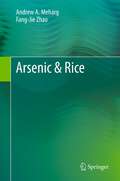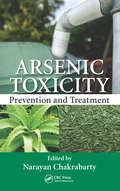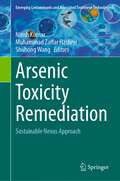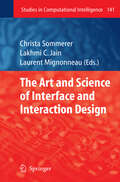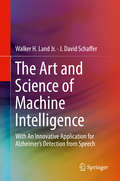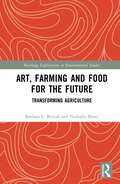- Table View
- List View
Arsenic & Rice
by Andrew A. Meharg Fang-Jie ZhaoRice is the staple food for half of the world’s population. Consumption of rice is the major exposure route globally to the class one, non-threshold carcinogen inorganic arsenic. This book explains the sources of arsenic to paddy soils and the biogeochemical processes and plant physiological attributes of paddy soil-rice ecosystems that lead to high concentrations of arsenic in rice grain. It presents the global pattern of arsenic concentration and speciation in rice, discusses human exposures to inorganic arsenic from rice and the resulting health risks. It also highlights particular populations that have the highest rice consumptions, which include Southern and South East Asians, weaning babies, gluten intolerance sufferers and those consuming rice milk. The book also presents the information of arsenic concentration and speciation in other major crops and outlines approaches for lowering arsenic in rice grain and in the human diet through agronomic management.
Arsenic Toxicity: Prevention and Treatment
by Narayan ChakrabartyThe most talked about metalloid in the modern world, arsenic affects the liver, kidney, and lungs; leads to cardiovascular diseases, cancer, and diabetes; and may cause blindness with long-time exposure. With naturally occurring arsenic boosted by mining and other industrial processes contaminating soil and drinking water, arsenic toxicity is a maj
Arsenic Toxicity: Challenges and Solutions
by Nitish KumarArsenic (As) is a widely distributed element in the environment having no known useful physiological function in plants or animals. Historically, this metalloid has been known to be used widely as a poison. Effects of arsenic have come to light in the past few decades due to its increasing contamination in several parts of world, with the worst situation being in Bangladesh and West Bengal in India. This edited volume brings together diverse group of environmental science, sustainability and health researchers to address the challenges posed by global mass poisoning caused by arsenic water contamination. The book covers sources of arsenic contamination, and its impact on human health and on prospective remediation both by bioremediation and phytoremediation. Applications of advance techniques such as genetic engineering and nanotechnology are also discussed to resolve the issue of arsenic contamination in ground water and river basins. The book sheds light on this global environmental issue, and proposes solutions to remove contamination through a multi-disciplinary lens and case studies from Bangladesh and India. The book may serve as a reference to environment and sustainability researchers, students and policy makers. It delivers an outline to graduate, undergraduate students and researchers, as well as academicians who are working on arsenic toxicity with respect to remediation and health issues.
Arsenic Toxicity Remediation: Sustainable Nexus Approach (Emerging Contaminants and Associated Treatment Technologies)
by Nitish Kumar Muhammad Zaffar Hashmi Shuhong WangArsenic contamination in drinking water and crops is a major health issue in many countries worldwide, threatening the health of millions of people due to arsenic’s toxicity and carcinogenicity. This edited volume brings together a diverse group of environmental science, sustainability and health researchers to address the challenges posed by arsenic contamination. The book sheds light on this global environmental issue and proposes solutions to aquatic contamination through multi-disciplinary sustainable approaches and case studies from different parts of the world. The chapters contained here present the status quo in different parts of the world and provide essential information on arsenic exposure risks for humans as well as possible measures for tackling arsenic poisoning. The mechanisms of arsenic uptake, translocation and distribution in plants and grains are also explained. In closing, the book reviews a variety of prospective sustainable solutions to the problem of arsenic accumulation in soil and water. The book is comprised of three sections. The first section describes the routes of exposure to environmental arsenic and its transport in soil and aquatic ecosystems. The second section explains the health risks linked to arsenic exposure in food and the environment. The third section addresses sustainable arsenic contamination mitigation strategies using the potential applications of recent biological technology such as biotechnology, bioremediation, phytoremediation, biochar, absorbent, genetic engineering, and nanotechnology approaches. The book is intended for a broad audience including researchers, scientists, and readers with diverse backgrounds.
Arsenic Toxicity Remediation: Biotechnological Approaches (Environmental Science and Engineering)
by Nitish Kumar Sanjeev KumarArsenic contamination in drinking water and associated adverse outcomes is one of the major health issues in more than 50 countries worldwide. The scenario is getting even more detrimental with increasing number of affected people and newer sites reported from all over the world. Apart from drinking water, the presence of arsenic has been found in various other dietary sources. Threatening the health of millions of people due to arsenic’s toxicity and carcinogenicity, the major routes of arsenic exposure for humans are either through drinking water or crops. This edited volume brings together a diverse group of environmental science, sustainability, and health researchers to address the challenges posed by global mass poisoning caused by arsenic water contamination. The book sheds light on this global environmental issue and proposes solutions to aquatic contamination through multi-disciplinary sustainable approaches and case studies from different parts of world. This book addresses the problem of arsenic by pursuing a holistic approach. It presents the status quo in different parts of the world and provides essential information on food-related arsenic exposure risks for humans and possible preventive and curative measures for tackling arsenic poisoning. The mechanisms of arsenic uptake, translocation, and distribution in plants and grains are also explained. In closing, the book reviews a variety of prospective sustainable solutions to the problem of arsenic accumulation in soil and water.The book comprises three sections. First section describes the routes of exposure to environmental arsenic and its transport in soil and aquatic ecosystems including its source and distribution in specific locations. Second section explains the health risks linked to arsenic exposure in food and the environment. Third section addresses sustainable arsenic contamination mitigation strategies using the potential applications of recent biotechnological techniques, bioremediation, phytoremediation, genetic engineering, nanotechnology, and in silico approaches.The book is intended for a broad audience including researchers, scientists, and readers with diverse backgrounds including agriculture, environmental science, food science, environmental management, and human health. It can also be used as an important reference guide for undergraduate and graduate students, university faculties, and environmentalists. The book may serve as a reference to environment and sustainability researchers, students, and policy makers.
Arsenic Water Resources Contamination: Challenges and Solutions (Advances in Water Security)
by Ali Fares Sushant K. SinghThis edited volume brings together a diverse group of environmental science, sustainability and health researchers to address the challenges posed by global mass poisoning caused by arsenic water contamination. The book sheds light on this global environmental issue, and proposes solutions to aquatic contamination through a multi-disciplinary lens and case studies from Bangladesh and India. The book may serve as a reference to environment and sustainability researchers, students and policy makers.Part one of the book describes the issue of arsenic contamination in ground water and river basins, including its source and distribution in specific locations in India. Part two explains the routes of exposure to environmental arsenic, its transport in aquatic ecosystems, and the health risks linked to arsenic exposure in food and the environment. Part three addresses sustainable arsenic contamination mitigation strategies and policies, the socioeconomic, demographic, cultural and psychological aspects of arsenic contamination, and the potential applications of GIS and remote sensing in providing solutions. Part four concludes by discussing the role of local and regional institutions in water resources management for a variety of issues including but not limited to arsenic contamination, and presents a case study in the Indus river basin in Pakistan to propose future contamination mitigation strategies.
Art and Illusionists (Vision, Illusion and Perception #1)
by Nicholas WadeWe delight in using our eyes, particularly when puzzling over pictures. Art and illusionists is a celebration of pictures and the multiple modes of manipulating them to produce illusory worlds on flat surfaces. This has proved fascinating to humankind since the dawning of depiction. Art and illusionists is also a celebration of the ways we see pictures, and of our ability to distil meaning from arrays of contours and colours. Pictures are not only a source of fascination for artists, who produce them, but also for scientists, who analyse the perceptual effects they induce. Illusions provide the glue to cement the art and science of vision. Painters plumb the art of observation itself whereas scientists peer into the processes of perception. Both visual artists and scientists have produced patterns that perplex our perceptions and present us with puzzles that we are pleased to peruse. Art and illusionists presents these two poles of pictorial representation as well as presenting novel ‘perceptual portraits’ of the artists and scientists who have augmented the art of illusion. The reader can experience the paradoxes of pictures as well as producing their own by using the stereoscopic glasses enclosed and the transparent overlay for making dynamic moiré patterns.
The Art and Science of 3D Audio Recording
by Edwin Pfanzagl-CardoneThis professional book offers a unique, comprehensive and timely guide on 3D audio recording. Intended for sound engineers and professionals, and summarizing more than twenty-year research on this topic, it includes extensive information and details on various microphone techniques and loudspeaker layouts, such as Auro-3D®, Dolby® AtmosTM, DTS:X®, MMAD, SONY 360 Reality Audio and Ambisonics. It presents a rich set of results obtained from both objective measurements and subjective listening tests, and a number of case studies for 3D recording, ranging from solo-instrument techniques to full symphony orchestra, and microphone systems for virtual reality applications. Further, it includes a chapter on spatial hearing discussing issues of 3D audio sound reproduction. All in all, this book offers extensive, practical information for sound engineers and professionals.
The Art and Science of Dome-Shaped Wood-Fired Ovens: Theory, Building Techniques, Thermal Profiling
by Nesimi ErtuğrulThe Art and Science of Dome-Shaped Wood-Fired Ovens, from history to your backyard or commercial shop, is a carefully crafted guide that explains the tradition and science of wood-fired cooking. The book embarks on a historical journey, tracing the development of wood-fired ovens and their cultural significance. It then unravels the theory of heating and the burning behaviour of wood, making complex technical concepts accessible.Transitioning from theory to practice, the guide outlines the design and construction process of a wood-fired oven. It considers engineering aspects and locally available materials, emphasizing efficient, sustainable building. The book discusses essential cooking utensils and tools, shedding light on the entire cooking process, from fire-starting to ash disposal.In a unique chapter on data logging, readers are introduced to modern temperature monitoring techniques. It shows how managing thermal mass can expand the range of recipes beyond the commonly perceived breads and pizzas. Lastly, the book explores Turkish cuisine, debunking preconceptions and presenting a wide array of dishes suitable for wood-fired ovens. The recipes span from traditional Turkish to International cuisines and fusion recipes, equipping readers with the tools to broaden their culinary repertoire.This book serves as an indispensable resource for anyone interested in wood-fired cooking, blending historical context, technical insights, practical advice, and mouth-watering recipes into a compelling narrative. This comprehensive manual aims to bring wood-fired cooking into the heart of modern culinary practice.
The Art and Science of Dome-Shaped Wood-Fired Ovens: Theory, Building Techniques, Thermal Profiling
by Nesimi ErtuğrulThe Art and Science of Dome-Shaped Wood-Fired Ovens, from history to your backyard or commercial shop, is a carefully crafted guide that explains the tradition and science of wood-fired cooking. The book embarks on a historical journey, tracing the development of wood-fired ovens and their cultural significance. It then unravels the theory of heating and the burning behaviour of wood, making complex technical concepts accessible.Transitioning from theory to practice, the guide outlines the design and construction process of a wood-fired oven. It considers engineering aspects and locally available materials, emphasizing efficient, sustainable building. The book discusses essential cooking utensils and tools, shedding light on the entire cooking process, from fire-starting to ash disposal.In a unique chapter on data logging, readers are introduced to modern temperature monitoring techniques. It shows how managing thermal mass can expand the range of recipes beyond the commonly perceived breads and pizzas. Lastly, the book explores Turkish cuisine, debunking preconceptions and presenting a wide array of dishes suitable for wood-fired ovens. The recipes span from traditional Turkish to International cuisines and fusion recipes, equipping readers with the tools to broaden their culinary repertoire.This book serves as an indispensable resource for anyone interested in wood-fired cooking, blending historical context, technical insights, practical advice, and mouth-watering recipes into a compelling narrative. This comprehensive manual aims to bring wood-fired cooking into the heart of modern culinary practice.
The Art and Science of HDR Imaging (The Wiley-IS&T Series in Imaging Science and Technology #26)
by John J. McCann Alessandro RizziRendering High Dynamic Range (HDR) scenes on media with limited dynamic range began in the Renaissance whereby painters, then photographers, learned to use low-range spatial techniques to synthesize appearances, rather than to reproduce accurately the light from scenes. The Art and Science of HDR Imaging presents a unique scientific HDR approach derived from artists’ understanding of painting, emphasizing spatial information in electronic imaging. Human visual appearance and reproduction rendition of the HDR world requires spatial-image processing to overcome the veiling glare limits of optical imaging, in eyes and in cameras. Illustrated in full colour throughout, including examples of fine-art paintings, HDR photography, and multiple exposure scenes; this book uses techniques to study the HDR properties of entire scenes, and measures the range of light of scenes and the range that cameras capture. It describes how electronic image processing has been used to render HDR scenes since 1967, and examines the great variety of HDR algorithms used today. Showing how spatial processes can mimic vision, and render scenes as artists do, the book also: Gives the history of HDR from artists' spatial techniques to scientific image processing Measures and describes the limits of HDR scenes, HDR camera images, and the range of HDR appearances Offers a unique review of the entire family of Retinex image processing algorithms Describes the considerable overlap of HDR and Color Constancy: two sides of the same coin Explains the advantages of algorithms that replicate human vision in the processing of HDR scenes Provides extensive data to test algorithms and models of vision on an accompanying website www.wiley.com/go/mccannhdr
The Art and Science of HDR Imaging (The Wiley-IS&T Series in Imaging Science and Technology #25)
by John J. McCann Alessandro RizziRendering High Dynamic Range (HDR) scenes on media with limited dynamic range began in the Renaissance whereby painters, then photographers, learned to use low-range spatial techniques to synthesize appearances, rather than to reproduce accurately the light from scenes. The Art and Science of HDR Imaging presents a unique scientific HDR approach derived from artists’ understanding of painting, emphasizing spatial information in electronic imaging. Human visual appearance and reproduction rendition of the HDR world requires spatial-image processing to overcome the veiling glare limits of optical imaging, in eyes and in cameras. Illustrated in full colour throughout, including examples of fine-art paintings, HDR photography, and multiple exposure scenes; this book uses techniques to study the HDR properties of entire scenes, and measures the range of light of scenes and the range that cameras capture. It describes how electronic image processing has been used to render HDR scenes since 1967, and examines the great variety of HDR algorithms used today. Showing how spatial processes can mimic vision, and render scenes as artists do, the book also: Gives the history of HDR from artists' spatial techniques to scientific image processing Measures and describes the limits of HDR scenes, HDR camera images, and the range of HDR appearances Offers a unique review of the entire family of Retinex image processing algorithms Describes the considerable overlap of HDR and Color Constancy: two sides of the same coin Explains the advantages of algorithms that replicate human vision in the processing of HDR scenes Provides extensive data to test algorithms and models of vision on an accompanying website www.wiley.com/go/mccannhdr
The Art and Science of Interface and Interaction Design (Studies in Computational Intelligence #141)
by Christa Sommerer Laurent MignonneauArtists and creators in interactive art and interaction design have long been conducting research on human-machine interaction. Through artistic, conceptual, social and critical projects, they have shown how interactive digital processes are essential elements for their artistic creations. Resulting prototypes have often reached beyond the art arena into areas such as mobile computing, intelligent ambiences, intelligent architecture, fashionable technologies, ubiquitous computing and pervasive gaming. Many of the early artist-developed interactive technologies have influenced new design practices, products and services of today's media society. This book brings together key theoreticians and practitioners of this field. It shows how historically relevant the issues of interaction and interface design are, as they can be analyzed not only from an engineering point of view but from a social, artistic and conceptual, and even commercial angle as well.
The Art and Science of Machine Intelligence: With An Innovative Application for Alzheimer’s Detection from Speech
by Walker H. Land Jr. J. David SchafferThis volume presents several machine intelligence technologies, developed over recent decades, and illustrates how they can be combined in application. One application, the detection of dementia from patterns in speech, is used throughout to illustrate these combinations. This application is a classic stationary pattern detection task, so readers may easily see how these combinations can be applied to other similar tasks. The expositions of the methods are supported by the basic theory they rest upon, and their application is clearly illustrated. The book’s goal is to allow readers to select one or more of these methods to quickly apply to their own tasks.Includes a variety of machine intelligent technologies and illustrates how they can work togetherShows evolutionary feature subset selection combined with support vector machines and multiple classifiers combinedIncludes a running case study on intelligent processing relating to Alzheimer’s / dementia detection, in addition to several applications of the machine hybrid algorithms
The Art and Science of Microelectronic Circuit Design
by Anatoly Belous Vitali SaladukhaThis book guides readers through the entire complex of interrelated theoretical and practical aspects of the end-to-end design and organization of production of silicon submicron integrated circuits. The discussion includes the theoretical foundations of the operation of field-effect- and bipolar transistors, the methods and peculiarities of the structural and schematic design, basic circuit-design and system-design engineering solutions for bipolar, CMOS, BiCMOS and TTL integrated circuits, standard design libraries, and typical design flows.
The Art and Science of NFC Programming
by Anne-Marie Lesas Serge MirandaNFC is a world standard since 2004 which is now within every smartphone on the market. Such a standard enables us to do mobile transactions (mobile payment) in a secure way along with many other information- based tap’n play operations. This book has a double role for computer scientists (from bachelor students in CS to IT professionals).
The Art and Science of NFC Programming
by Anne-Marie Lesas Serge MirandaNFC is a world standard since 2004 which is now within every smartphone on the market. Such a standard enables us to do mobile transactions (mobile payment) in a secure way along with many other information- based tap’n play operations. This book has a double role for computer scientists (from bachelor students in CS to IT professionals).
The Art and Science of Rotating Field Machines Design: A Practical Approach
by Vlado OstovićThis book highlights procedures utilized by the design departments of leading global manufacturers, offering readers essential insights into the electromagnetic and thermal design of rotating field (induction and synchronous) electric machines. Further, it details the physics of the key phenomena involved in the machines’ operation, conducts a thorough analysis and synthesis of polyphase windings, and presents the tools and methods used in the evaluation of winding performance. The book develops and solves the machines’ magnetic circuits, and determines their electromagnetic forces and torques. Special attention is paid to thermal problems in electrical machines, along with fluid flow computations. With a clear emphasis on the practical aspects of electric machine design and synthesis, the author applies his nearly 40 years of professional experience with electric machine manufacturers – both as an employee and consultant – to provide readers with the tools they need to determine fluid flow parameters and compute temperature distributions.
The Art and Science of Surround and Stereo Recording: Including 3D Audio Techniques
by Edwin Pfanzagl-CardoneThis book presents an extensive and timely survey of more than 30 surround and 20 stereo-microphone techniques. Further, it offers, for the first time, an explanation of why the RCA "Living Stereo" series of legacy recordings from the 1950s and 60s is still appreciated by music lovers worldwide, despite their use of an apparently incorrect recording technique from the perspective of psychoacoustics. Discussing this aspect in detail, the book draws on the author’s study of concert hall acoustics and psychoacoustics. The book also analyzes the "fingerprint" features of a selected number of surround and – more importantly – stereo microphone techniques in depth by measuring their signal cross-correlation over frequency and also using an artificial human head. In addition, the book presents a rating of microphone techniques based on the assessment of various acoustic attributes, and merges the results of several subjective listening tests, including those conducted by other researchers. Building on this knowledge, it provides fresh insights into important microphone system features, from stereo to 3D audio. Moreover, it describes new microphone techniques, such as AB-PC, ORTF-T and BPT, and the recently defined BQIrep (Binaural Quality Index of reproduced music). Lastly, the book concludes with a short history of microphone techniques and case studies of live and studio recordings.
Art, Farming and Food for the Future: Transforming Agriculture (Routledge Explorations in Environmental Studies)
by Barbara L. Benish Nathalie BlancThis book explores the impact of artistic experiments in inspiring people to turn away from current food consumerism and take an active role in preserving, sustaining, and protecting the environment. As artists are expanding their practice into social justice and community concerns, erasing traditional forms of expression and integrating others, the culture around food and its production has been added to a new vocabulary of experiential art. The authors measure the impact of such experiments on local food consumption and production, focusing on education and youth, both in the surrounding community and culture at large. They suggest how these projects can be up-scaled to further encourage sustainable solutions for our environment and communities. The book explores the reflections and motivations of case study practitioners in urban and rural areas and, through interviews, engages with artists who are pioneering a new trend to create hubs of activity away from traditional art spaces in cities to follow a non-hierarchal practice that is de-centralized and communally based. This book will be of great interest to academic readers concerned with issues related to environmental aesthetics, eco-design, eco-criticism, culture, heritage, memory, and identity, and those interested in the current debates on the place of aesthetics and culture in sustainability.
Art, Farming and Food for the Future: Transforming Agriculture (Routledge Explorations in Environmental Studies)
by Barbara L. Benish Nathalie BlancThis book explores the impact of artistic experiments in inspiring people to turn away from current food consumerism and take an active role in preserving, sustaining, and protecting the environment. As artists are expanding their practice into social justice and community concerns, erasing traditional forms of expression and integrating others, the culture around food and its production has been added to a new vocabulary of experiential art. The authors measure the impact of such experiments on local food consumption and production, focusing on education and youth, both in the surrounding community and culture at large. They suggest how these projects can be up-scaled to further encourage sustainable solutions for our environment and communities. The book explores the reflections and motivations of case study practitioners in urban and rural areas and, through interviews, engages with artists who are pioneering a new trend to create hubs of activity away from traditional art spaces in cities to follow a non-hierarchal practice that is de-centralized and communally based. This book will be of great interest to academic readers concerned with issues related to environmental aesthetics, eco-design, eco-criticism, culture, heritage, memory, and identity, and those interested in the current debates on the place of aesthetics and culture in sustainability.
The Art of Carbohydrate Analysis (Techniques in Life Science and Biomedicine for the Non-Expert)
by Gerrit J. GerwigThe growing importance of glycobiology and carbohydrate chemistry in modern biotechnology and the pharmaceutical industry makes accurate carbohydrate analysis indispensable. This book provides the principles and protocols of various fundamental carbohydrate analysis methods. Choice of method is entirely dependent upon the type of material being investigated (biological samples, food products, etc.), and the level of structural detail required, i.e. sugar content, compositional analysis, linkages between the sugar components, or the total chemical structure of a given molecule. Full structural characterization of carbohydrate chains requires significant time, resources, and skill in several methods of analysis; no single technique can address all glycan analysis needs.This book summarizes several existing analytical techniques (both chemical and physical) in an introductory volume designed for the non-expert researcher or novice scientist. While background in carbohydrate chemistry is assumed, all information necessary to understanding the described techniques is addressed in the text.
The Art of Ceramic Extrusion
by Frank HändleThis book is ideal for practitioners and managers with low experience in the field. It introduces the theme of extrusion in ceramics and provides checklists, questionnaires, as well as the related literature and websites covering the topic. This Brief is written in a simple language and covers topics such as honeycombs, ceramic filters, auger geometry, wear and tear.
Art of Digital Audio
by John WatkinsonDescribed as "the most comprehensive book on digital audio to date", it is widely acclaimed as an industry "bible". Covering the very latest developments in digital audio technology, it provides an thorough introduction to the theory as well as acting as an authoritative and comprehensive professional reference source. Everything you need is here from the fundamental principles to the latest applications, written in an award-winning style with clear explanations from first principles. New material covered includes internet audio, PC audio technology, DVD, MPEG audio compression, digital audio broadcasting and audio networks.Whether you are in the field of audio engineering, sound recording, music technology, broadcasting and communications media or audio design and installation, this book has it all. Written by a leading international audio specialist, who conducts professional seminars and workshops around the world, the book has been road tested for many years by professional seminar attendees and students to ensure their needs are taken into account, and all the right information is covered.This new edition now includes:Internet audioPC Audio technologyDVDMPEG Audio compressionDigital Audio BroadcastingAudio networksDigital audio professionals will find everything they need here, from the fundamental principles to the latest applications, written in an award-winning style with clear explanations from first principles.John Watkinson is an international consultant in audio, video and data recording. He is a Fellow of the AES, a member of the British Computer Society and a chartered information systems practitioner. He presents lectures, seminars, conference papers and training courses worldwide. He is the author of many other Focal Press books, including: the Kraszna-Krausz award winning MPEG-2; The Art of Digital Audio; An Introduction to Digital Video; The Art of Sound Reproduction; An Introduction to Digital Audio; TV Fundamentals and Audio for Television. He is also co-author, with Francis Rumsey, of The Digital Interface Handbook, and contributor to the Loudspeaker and Headphone Handbook, 3rd edition.
Art of Digital Audio
by John WatkinsonDescribed as "the most comprehensive book on digital audio to date", it is widely acclaimed as an industry "bible". Covering the very latest developments in digital audio technology, it provides an thorough introduction to the theory as well as acting as an authoritative and comprehensive professional reference source. Everything you need is here from the fundamental principles to the latest applications, written in an award-winning style with clear explanations from first principles. New material covered includes internet audio, PC audio technology, DVD, MPEG audio compression, digital audio broadcasting and audio networks.Whether you are in the field of audio engineering, sound recording, music technology, broadcasting and communications media or audio design and installation, this book has it all. Written by a leading international audio specialist, who conducts professional seminars and workshops around the world, the book has been road tested for many years by professional seminar attendees and students to ensure their needs are taken into account, and all the right information is covered.This new edition now includes:Internet audioPC Audio technologyDVDMPEG Audio compressionDigital Audio BroadcastingAudio networksDigital audio professionals will find everything they need here, from the fundamental principles to the latest applications, written in an award-winning style with clear explanations from first principles.John Watkinson is an international consultant in audio, video and data recording. He is a Fellow of the AES, a member of the British Computer Society and a chartered information systems practitioner. He presents lectures, seminars, conference papers and training courses worldwide. He is the author of many other Focal Press books, including: the Kraszna-Krausz award winning MPEG-2; The Art of Digital Audio; An Introduction to Digital Video; The Art of Sound Reproduction; An Introduction to Digital Audio; TV Fundamentals and Audio for Television. He is also co-author, with Francis Rumsey, of The Digital Interface Handbook, and contributor to the Loudspeaker and Headphone Handbook, 3rd edition.
